Monterey Car Week is over, but as your volunteer eyes, ears, tongue, and clammy hands at the event, I still have a lot of top-shelf car stuff to show you from the events, because I made a solemn pledge to do just that. And, I know that for most of you – at least the most influential and important ones, of course – what you really want to see are the taillights, indicators, headlights, and other lighting hardware from the finest car show in the known universe. I realize that no human can adequately do this task, but I’m going to take a stab at it now, showing you 42 of the most interesting and important or maybe just confusing examples of automotive lighting I encountered.
So, kick everyone out of your office, end class early, adjourn the court, get your nurse to close the patient, land in a field or something, do whatever you need to do so you can focus your full attention on all the taillight (and more) goodness I’m about to sling your way.
Let’s start with something really special, right off the top:

See this incredible and shockingly minimalistic taillight? That’s from the 2011 Pebble Beach Concours D’Elegance Best in Show winner, this 1934 Voisin C-25 Aerodyne. Voisin was an aircraft designer originally, and the lessons of extreme lightness clearly carried over to this remarkable car, as you can see in this remarkable taillight, one of the only designs that’s so minimalistic as to be open, more of an aluminum and celluloid screen wrapping around a lone bulb.

The parking lights (perhaps adapted into turn indicators, too) on the front are similar, a light aluminum structure, punctuated with holes, enclosing a plastic amber sheath around a bulb. Fasteners are large and unashamed, and the whole thing has a constructivist, modern look that meshes perfectly with the overall mechanical-celebratory look of the car. These are unusual and stunning, deceptive in their simplicity and more powerful the longer you contemplate them.
Next up we have this devious little rule-breaker, a 1937 BMW 328 race car:

Red covers over the lights? Red? In front? what madness is this, breaking the most fundamental rule of automotive lighting: white in front, red at the rear. I asked a person attending to the car, I guess the car’s valet, about this, and I was told the original intent was to make the car look “menacing” when racing. I can see that, but I bet confusion was part of the equation, too.
This 1947 Talbot Lago’s light isn’t necessarily that stunning on its own, but it’s a lovely example of what a parts-bin light of this era was like:

A simple little can, with a round red lens and a clear cutout for license plate illumination. It’s so straightforward and simple I can’t help but be charmed. Where this one is simple and straightforward, we have the opposite extreme on this 1946 Alfa Romeo 2500:
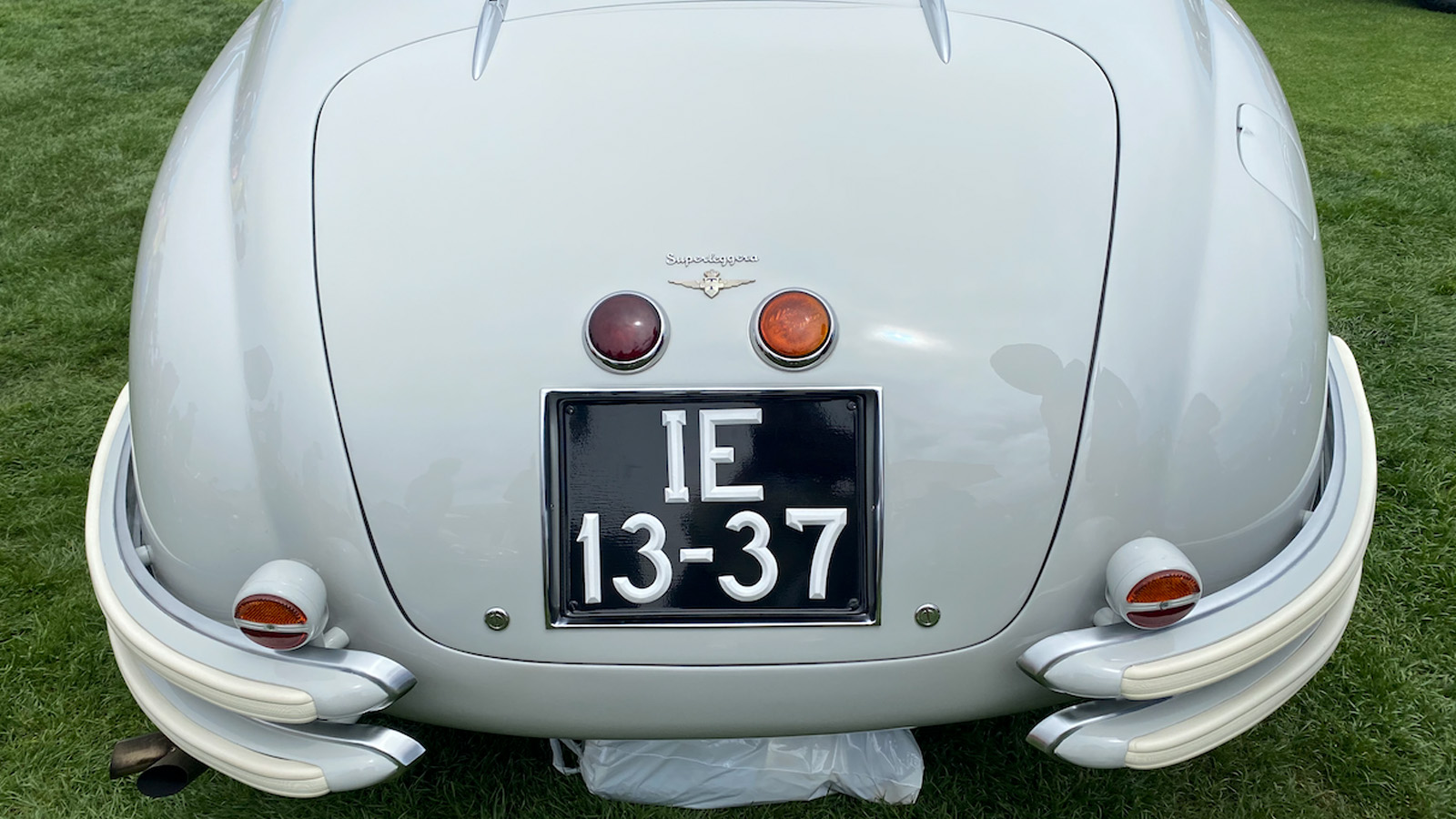
The light units themselves aren’t particularly odd, but what the hell is going on with the light types and arrangement? One red and one amber light in the center? What the hell do they do? What do you do with one amber lamp? Indicate just the general idea of a turn, without getting into the tedious specifics of left or right?
I suspect those lower half-amber/half-red lights on the bumper were added later to compensate for the confusing mess of those original two lights mounted in the trunk lid. What were you trying to do here, Alfa?
Not to be outdone, we have some other exciting strangeness on this ’51 Lancia B20:

A green foglamp? Nobody uses green on vehicle lighting, well, except for questionably-legal LED accessory crap. I don’t think I’ve ever seen a lime Jell-O colored lamp like this on a car before, but I kinda love the gleeful perversity of it.
Also strange, but more subtly so, was this lighting setup on a 1954 Aston Martin bodied by Graber:

I’m not sure if that lower, frosted lamp is a reverse lamp, or if that’s a red bulb inside there. It’s interesting in how much it differs from the more parts-bin red gumdrop lens above, and I’m not certain why the frosted section only extends 3/4 of the way down. It’s clean and crisp-looking, though!
This next one is really remarkable. It’s the indicator repeater on a 1959 OSCA 1600 bodied by Michelotti:
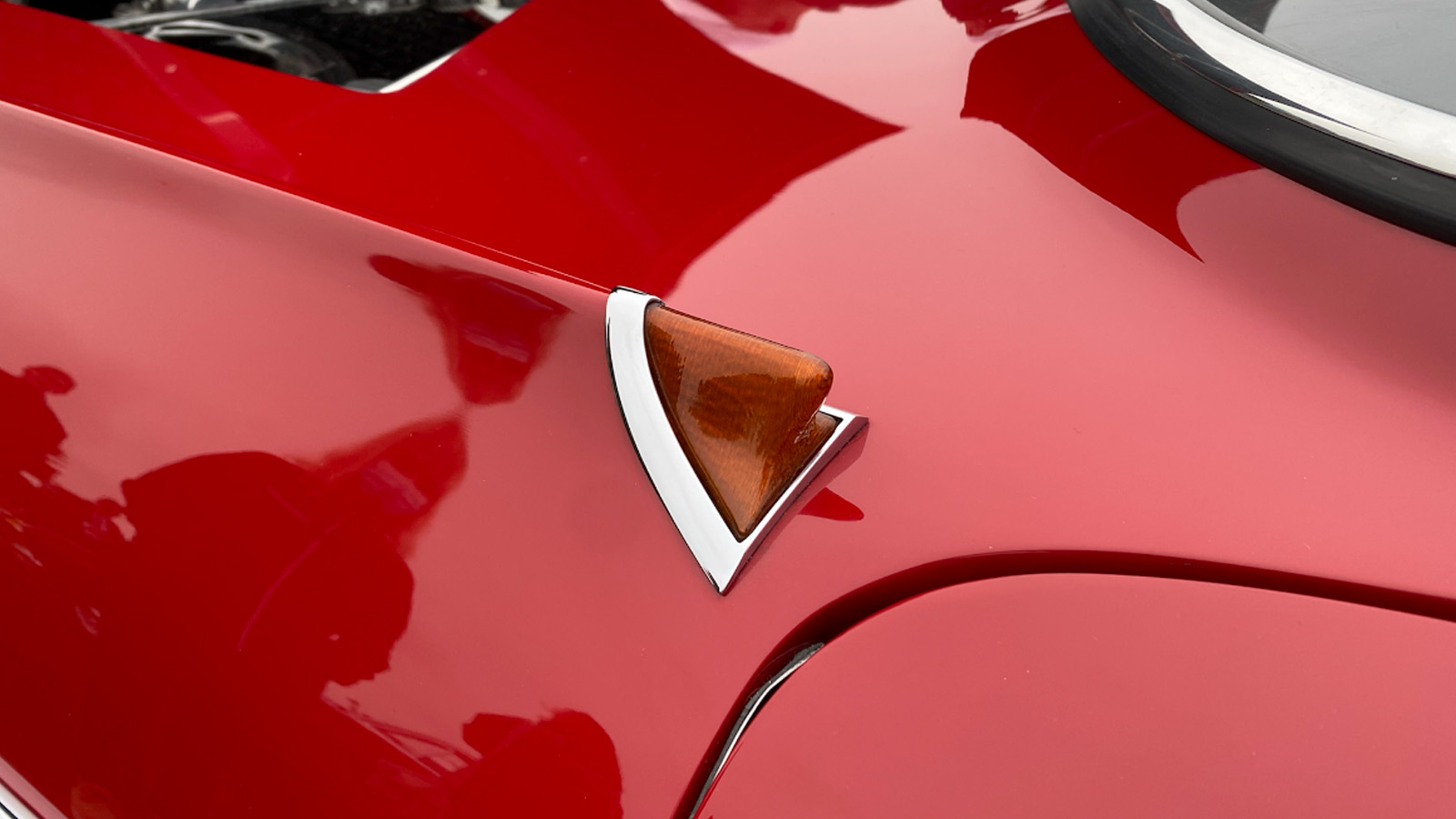
Honestly, everything about this car I found amazing, and I’m going to do a longer writeup about it, because it feels like a car a solid six or so years ahead of its time. It’s a fantastic design with all kinds of great details, including what may be the most exuberant and best indicator repeater I’ve ever encountered sober and awake. It sort of looks like the nose of an amber person peeking through a hole.

The rolling mass of patina you see up there was this years Concurs D’Lemons winner, a 1960 BMW 502 in deliriously shitty condition. The taillight setup on these is pretty incredible, with an upper elongated teardrop-shaped lamp that echoes the look of the front-fender parking lamps/indicators, and a pair of small round bumper-mounted taillights that seem to be installed on most, but not all of these.
The teardrop’s lens looks like it could be amber or red but that could be age and sun-related. Even in this condition, it’s a lovely lighting setup.
This next one, on a 1964 Alfa Romeo TZ, I mostly have here for the details:

It’s that tiny side marker lamp, made by simply cutting a window into the light barrel and sticking a tiny amber lens over the hole, no bigger than a butterscotch candy, that gets me here. This is a bit prior to mandated side marker lamps, which makes it even more interesting.
Let’s keep rolling! Look at the headlights on this 1964 Alvis:

At first glance they look like a pair of stacked round sealed-beam lamps, but when you look closer you see they’re actually one tall ovoid light unit, with two headlight lenses and what seem to be an integrated indicator and sidelight. I think they’re as classy as that poster of a rose on a piano keyboard, if not more so.
This next one is the only example where you can’t actually see the lights I’m so taken by:

That’s a 1967 Ferrari 330 GTC Pininfarina Speciale, and what I want you to note is that incised circle, which is the cover for a pop-up foglamp. I can’t think of any other car that has exposed headlights and pop-up foglights! It’s so flapjacking cool, I can’t deal. The drama of tearing ass on some misty day and popping these babies open? So good.

That same car has some wonderful taillights, made even better, I think, because it’s just a very stylish application of some parts-bin lights and lenses. The addition of the red reflector on the clear reverse lamp is the punctum here.

Yet another Alfa Romeo 2500, this time one converted into a truck and with an enviable patina. I want you to see the lovely Deco-style fluted headlight lens going on here.
This next light unit is interesting because there’s very few cars that would need it, but for those particular cars, it’s absolutely required:

This isn’t a light for land, it’s a light for sea, a maritime-law-required port and starboard lamp, as seen on the hood of an Amphicar. The Amphicar designers pinched a few deutchmarks here and only used one bulb for the two lights.
This next taillight, from a BMW 507, is interesting because the basic design is almost exactly the same as a Volvo P1800. I don’t necessarily think this was an intentional homage, but maybe?

I haven’t included any modern cars on here, but there was one notable example of a modern automaker really trying hard on their taillight design, the bargain city-car maker Bugatti, who makes cars that are normally cross-shopped with things like Dacias or used Renaults.

The new Bugatti Mistral has these extruded BUGATTI letters and some very circuit-like linear illuminated lines in a huge wraparound taillight assembly. It’s bold! And, I bet, cheap to replace!
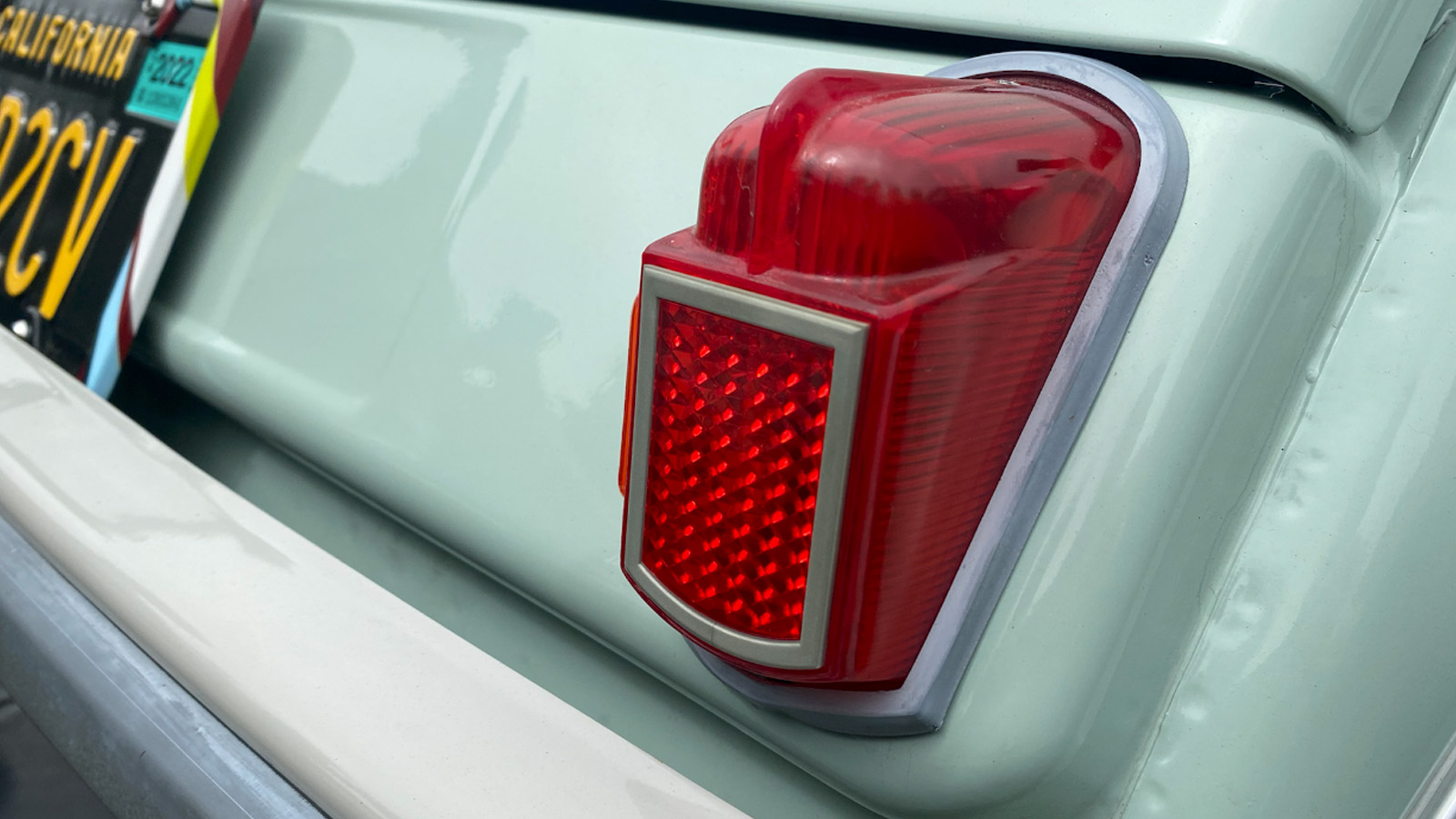
There’s something about early Citroën 2CV lights that I always loved. They’re small and charming and feel like they could be used to hold sugar on a cafe’s tea or coffee set, or something. Here’s another Citroën light:

That’s from a Traction Avant, but not just any Traction Avant, this is one that’s been convertered during WWII to run on woodgas, a desperation fuel made by cooking the gases out of wood or coal or banned books or whatever you could get your hands on. We’ll have a video with more details about these cars soon, but until then, please appreciate the floral/honeycomb lens pattern of this novel little sidelight.

You can’t walk by a Ford Cortina’s incredible taillights and not take a pic, right? You can’t.

Okay, I can’t recall what car this tiny, archaic light unit was on, but it looks just like an old diver’s helmet.
This next example, nestled into a fin-recess in this 1958 Chrysler Dual-Ghia 400 prototype, is notable not because the light unit itself is all that remarkable – it’s sort of just a red and white elongated piece of candy corn – but more for the way it’s inset, perhaps Frenched (we’ll have a story about this concept coming soon, too) into the bodywork. It’s so much better than if it was flush with the bodywork.

I saw a number of these lights on mostly old Dusenbergs, and I admire their straightforward safety-conscious utility:

STOP, it tells you, redly. Don’t hit me! It’s also unusual because I think that clear white light bulb in the center is the basic taillight, which feels weird and wrong. These things are also huge, and may just be adaptations of headlight units.

Remember this car? This is the 1953 Fiat 8V Supersonic that’s worth around two million dollars and our own David Tracy fixed with his grubby, rusty mitts. I like the taillights because they so well convey the whole Jet Age/jet exhaust theme of the car, and they’re dead ringers for a number of early ’60s Ford lights.

Dammit, I can’t quite recall what car this one above is from, but I really like how that odd seven-sided chrome bezel really dresses up that simple catalog taillight lens in an unexpected way.
This 1936 HRG 1500 race car below has a lot going on, lighting-wise: those surprised-looking and nicely meshed headlights, for example.

But what got me is that oval driving lamp off to the side there; the size and proportions of it were so subtly strange, I had to pause a moment to really take it in.

I talked to the owner of this custom-bodied Lincoln about those amber lights on the sides of the hood, calling them “turn indicators.” I was corrected, punctuated with a bracing slap across my face, and informed that these predate flashing turn inidactors, and are simply parking lights.
Okay, fine, but they would make fantastic turn signals all the same.
This Maserati had such simple, pleasant taillights that I had to include them:

Nothing special, even in their era, but they’re just so tidy and pleasant.
Ever heard of Matford? They were a short-lived (1934 to 1940) French joint venture between Mathis and Ford.

This one I think is a Ford V8-powered Matford Alsace, and it has headlights with incredibly bubbly outer glass lenses. They’re slightly fluted and have that static-pattern on the outer rim. There’s some thing very appealing about them.
These next taillights, seen on a Peugeot Bébé from around 1906 or so, have to be the tiniest, most delicate taillights I’ve ever seen.

They’re Marchal-built units, and are essentially a tiny, pocket-sized tube that holds a bulb, some wire, and has a little shield-shaped and rectangular hole in it, skinned with red celluloid. They feel like jewelry.
Let’s do one more tiny one: this PTV, a very rare Spanish microcar, has these impossibly tiny indicator/parking lamps. They look like an owl’s eye or something like that. Technically, this was a car our co-founder Beau Boeckmann got and wasn’t at Monterey, but I still wanted to show you.

A number of cars had these, and while they’re not exactly taillights, they’re made with red reflectors so they’re taillight-adjacent:

They’re those letters European countries use to identify where their cars are from. This I means Italy, and I saw some Fs and Gs and other letters, too. They’re very taillight-like.
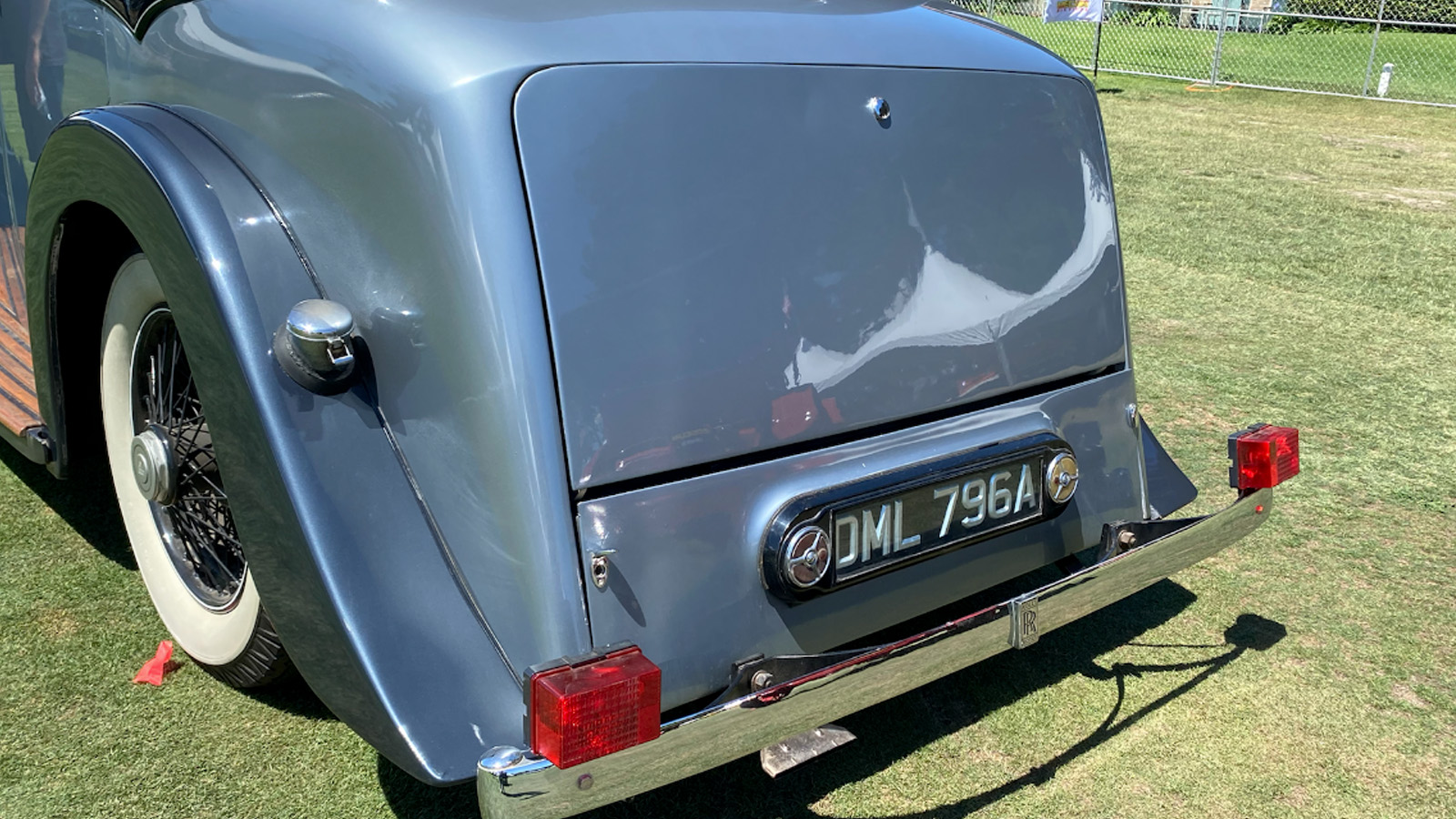
Okay, this one is my lone call-out to scold and shame: who put these truck-stop shitbrick taillights on this old Rolls-Royce? Come on. This is a crime. I get that you may need to have auxiliary lighting (those original taillights, on either side of the license plate, aren’t cutting it) but jeez, pick something – anything – better, people.
Whoever owns this old Roller is clearly loaded, and could sure as hell afford something better than those two ugly cubes they slapped on. I’d tow this shit off my lawn if I was in charge.

America has always had a flair for the dramatic, and this 1954 Buick Skylark absolutely proves that. Look at that glorious, exuberant chrome hood on that taillight, with those extra red illuminated gills! Fantastic.

This is another one I can’t recall the make of, but I really appreciate how that incised starburst completely changes what would have been a pretty forgettable round lamp into something special.

These STOP lights with the sort of dog paw-pad shape up top and the oval window in the bottom were supplier/aftermarket items found on many cars, but I wanted to take a moment to appreciate them. Words in a taillight are all but gone now, especially urgent commands like STOP (though maybe DODGE still exists) but I do like their clear urgency.
Oh, here’s another tiny yet powerful light:

This little gem is one of the innumerable incredible details found on a car I mentioned last week, the 1948 Talbot-Lago Grand Sport Figoni Fastback Coupé. (Oh wait, this was another Figoni Talbot-Lago, not the Zipper King one) This is a parking lamp, set above the glorious flappy semaphore turn indicator, and this lamp’s job was to shine steadily, red to the rear and white to the front, as the car was parked on a narrow, dark street, to visually announce its presence to any inattentive drivers that may be squeaking by.
It’s like a crystal ziggurat and its reflection in a blood red river, rotated 90°. It’s yet another tiny drip of magic on an already magical car.

This picture is less about the specific car than it is to reveal yet another one of my automotive lighting kinks: taped lenses for racing. I love it. I don’t know why, but put an X of tape over a lens and it makes any car look cooler, tougher, better. I can’t explain it, and won’t.

I wrote about this incredible British Thames van I saw in the Laguna Seca parking lot the other day, and I just now noticed how confusing its taillights are. The turn indicators are up where you’d expect the main taillights to be, but the actual brake and taillights are way down there at the bottom. The red reflector under the high indicators is just another element of confusion. I’m not exactly sure why, but this throws me.
Randy Carlson, the legendary VW expert and restrorer behind oldbug.com, brought this old Type 2 Microbus to the Concurs D’Lemons, and it sported some taillight lenses I’ve never seen before:

They fit in the usual Type 2 chrome bezel and location, but instead of being flat, they extend out about an inch and are fluted. Randy thinks they’re just some period aftermarket lens, and notes that they do make the lights much more visible around corners. I think they’re great.
That’s probably enough taillight content for now, but I suspect you needed every single one of these. I hope when you go to your local taillight bar or bathhouse tonight you feel like you have plenty to discuss, because, friends, you absolutely do.






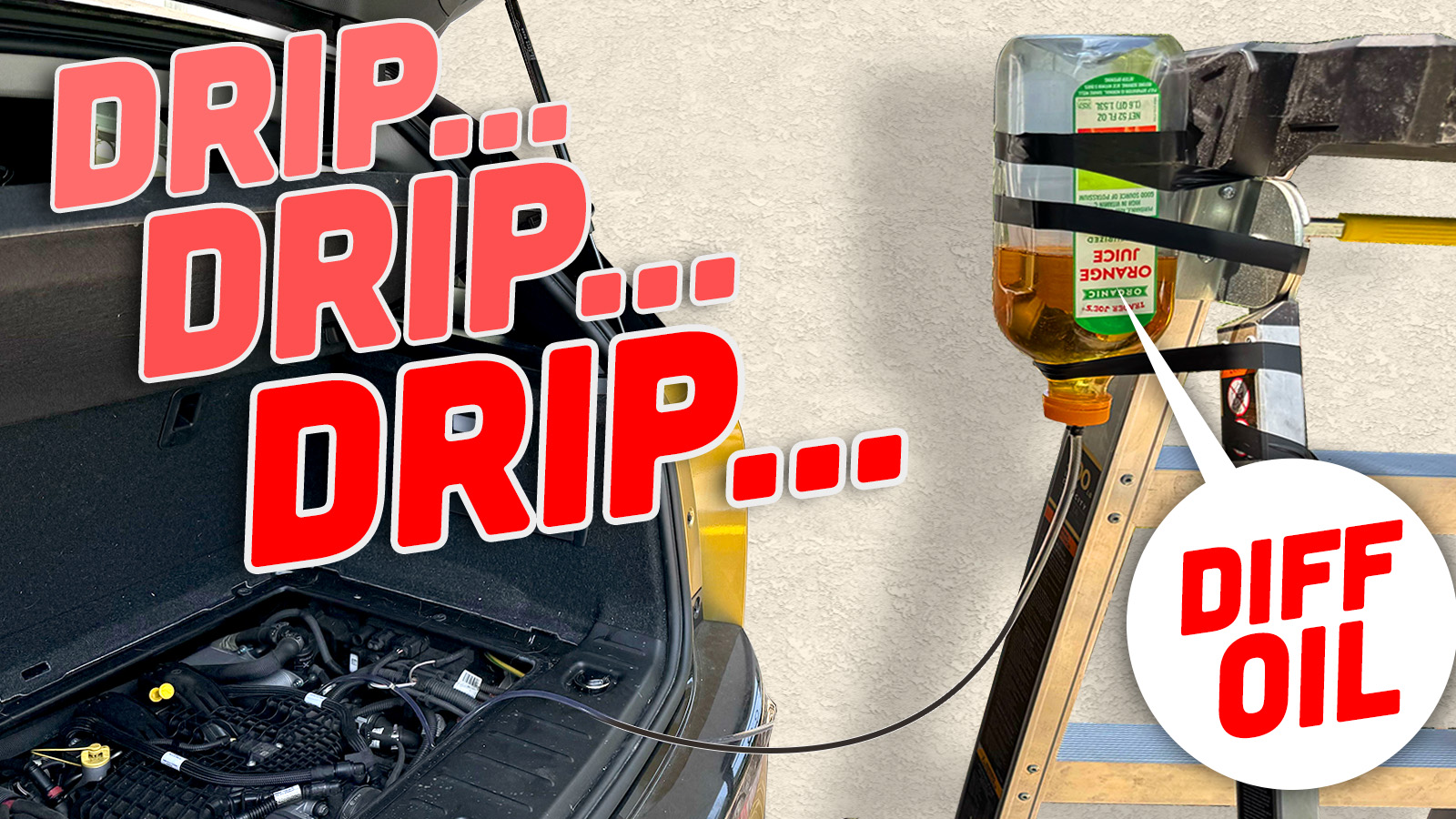
If you guys ever need someone who obsesses over dashboard dials, knobs, needles, and indicators, sign me up because you are rocking the dream job on the light front. The writing quality also helps in heaps.
Torch, a piece (or pieces( on the great European headlight manufacturers like SEV Marchal, Cibie, and Hella would be amazing. I’m old enough to remember when a set of Marchal or Cibie seal beam replacements was a big deal…
Ahh, the Ford Cortina taillight. So hard to beat that functional beauty.
I really enjoyed this collection of taillight minutia, even though it was dripping with Torchinsky orgasmic juices.
Can we please get the same topics started but regarding wheels. EVERYTHING WHEEL desing. that would be neat. I have so much to say
The “diver helmet” was probably on an old Bentley. Late 20s-early 30s Bentley’s had those style lights, and Bentleys are usually well-represented at PB.
Torch, next time they let you near Pebbles, Beaches, or Fancy cars, it would be great if you could get them to turn on the lights. I think some of the usage / design of the lights is lost by the lack of bulb brightness. I don’t know if the event runs to/past dusk, but they’re really missing a great chance to show off vehicles and their curves / lighting by not having a lights on portion and just running power cables to keep 12V going.
Then you’ll not only see which light is associated with which interior control, but also how the bulb placement works with the fancy glass (or not) to create illumination.
Please please please tell me the headlight on that Alvis is not a sealed beam and uses replaceable bulbs.
“A green foglamp? Nobody uses green on vehicle lighting…”
Torch, you’ll probably find this use of green lights interesting: up until the 60s, at least in Spain (no sure about the rest of Europe, but I doubt it, traffic regulations at that time were far from standardized), trucks used to have a green tail light on the left side.
Trucks were painfully slow, and the purpose of the green light was to make overtaking them easier. The truck driver would keep an eye for traffic behind him and turn the light on to indicate that they had seen you and were aware of your intention to overtake. Then, once the road ahead was clear and it was safe to do so, he would indicate drivers to pass using his right turn signal.
However, it’s use was not well understood by many drivers, who would mistake the green light for an indication that it was safe to pass, often leading to accidents, and the green light disappeared past the 60s.
I have no idea whether its use was regulated or it was something truck drivers fit on their own initiative.
BTW, I’m not that old, I was born in 1980, but there was a scrap metal dealer in my area that used to run ancient trucks in his business and I remember one of them had the green tail light. I asked my father and he told me what it was for.
I have found some old truck tail lights with the green light integrated, so I guess it was somehow regulated:
https://www.milanuncios.com/recambios-de-coches-clasicos/piloto-trasero-camion-220105310.htm
https://www.todocoleccion.net/repuestos-coches-motos/camiones-antiguos-tulipa-para-faro-trasero-estrenar~x95096571
https://www.clasf.es/pilotos-traseros-camion-pegaso-en-moreda-de-%C3%A1lava-42715618/
This is incredible! I’ll look into it for a full write-up!
The ’64 Alfa TZ’s amber lozenge is an indicator repeater, not a side marker, and had already been required since the mid ’50s in Italy. With its’ huge numbers of bikes and scooters sharing narrow roads with a skyrocketing number of cars, they were the first country in the world to require side repeaters. Interestingly export models of Italian cars had them pretty much universally from that point on.
That Dual-Ghia’s taillights are so frustrating, since they look so similar to a production Mopar item from the mid ’50s, most likely Chrysler-Plymouth since Dodge and DeSoto preferred stacks of round units but they’re not an exact match for, say, ’56 Plymouth ones. Parts bin-adjacent but not quite.
Green lights or side markers were common for slow véhicules, if it was on, it meant that you could overpass the vehicule safely.
So…was this you as a child?
https://tenor.com/view/bart-simpson-belt-indicator-gif-23836461
I have fond memories of the dog paw STOP lamp. My grandfather enjoyed restoring cars built between the world wars, and he put these on several of them-especially on ones he built mainly as parade cars. IF I’m recalling correctly, they were still in the JCWhitney catalogue in the ‘90s. I know a Domino’s delivery driver who used one as a CHMSL in his ‘68 Beetle after he got rear-ended in the mid ‘90s.
“A green foglamp? Nobody uses green on vehicle lighting…”
Here in Washington a front-facing green light indicates a firefighter’s private vehicle being used for emergency duty. I like the idea of a firefighter having a 1951 Lancia ready to go, just in case.
https://app.leg.wa.gov/rcw/default.aspx?cite=46.37.185
Yeah, but do you have green foglamps, or a Lancia? If not GTFO.
Blue for volunteer firemen in action, in NY state.
And green for volunteer ambulance, apparently.
https://www.extremetacticaldynamics.com/knowledge-base/state-statutes/new-york
I would prefer my local firefighter to have a Chevy truck.
I love Lancias but not while my house is burning.
So glad to see the rarely used and often misunderstood heptagon featured here.
“It’s a fantastic design with all kinds of great details, including what may be the most exuberant and best indicator repeater I’ve ever encountered sober and awake.”
PLEEAAAASE provide a whole post of drawings you have dreamed of while NOT sober. We need this.
Pop up fog lights?
Hell yes.
Because they are a type of auxilary light, would these be legal in the US? Cause…..I’m having thoughts…..
Torch, I used to 100% not get you and your fascination with tail lights (or turn signals, head lamps, parking indicators, or whatever)
But reading about punctum and reading about your obsession with the fluting on some of these, or how they were frenched into the body, and how they just kind of grab you, I kind of got it.
I picked up an antique boat from the 50s a while back, it was an absolute mess. Several inches of dirt in it, multiple plants growing in it, covered in a horrible attempt at a camo paint job, as well as several other horrible bits.
My mom very quietly didn’t say anything. My sisters both said many things. My wife gave me this long-suffering look that she gets sometimes.
But Dad, the same man that minored in art history and still has sculptures he created in his college courses, the same man that trained at the Smithsonian’s Furniture Conservation Training Program, the man that loves mid-century modern architecture and furniture; he looked at it and said “wow! look at the lines on that!” and went up to it and started to point out features that I had seen but maybe hadn’t really noticed.
And I saw them as well. And I paid special attention to them when I cleaned the boat up and got it back on the water.
And reading about what you saw there, I kind of see it.
I’m not obsessed with them, but I’m not at 100% not getting it. Maybe I’m at 80-90% not getting it.
Regardless of how much you get it though, the lights on that Rolls are a damn travesty.
Yeah, definitely starting to get some sort of vehicle lighting Stockholm Syndrome creeping in.
I certainly enjoyed this article far more than a well adjusted individual should (to be fair to Torch, I’ve never been described as a well adjusted individual, so he’s not entirely to blame).
Thoughts from an old:
Remember inset red tail lenses in Chrysler products in their longer lower wider days. The more expensive trims had full size lenses and the less expensive had the French edge type. Because bigger is better.
And
Thinking those various lenses aren’t parts bin. In their day probably were custom manufactured originals.
Gimme that British Thames van. Chop the top by a couple of inches add a V10 for giggles and shits and upgrade the suspension and other stuff. Bam one bad motherfucker.
Pop up fog lamps FTW!!!
Those trailer lights on the Rolls? I get it, for purely practical purposes when driving. But they could/should have been designed with a quick disconnect/dismount system so they could be removed for shows. That would be better.
David’s been gone for a day and we’re already getting that pure, uncut Torch taillight goodness.
>1946 Alfa Romeo 2500
Red is the taillight, amber the brake light.
I did encounter another earlier example of an amber brake lamp, so that makes sense. Still feels wrong.
I’ve seen it on some vintage motorcycles as well, with the lights usually in a vertical configuration.
Always looks like someone is indicating up/down for a sec.